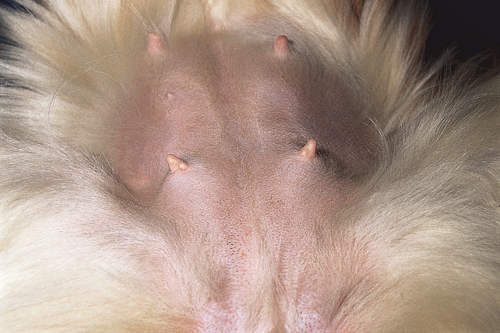Small Animal Abdominal and Metabolic Disorders Q&A 16
| This question was provided by Manson Publishing as part of the OVAL Project. See more Small Animal Abdominal and Metabolic Disorders Q&A. |
A two-year-old, female Springer Spaniel has swelling of all mammary glands and the production of a small volume of milk six weeks after her previous oestrus.
| Question | Answer | Article | |
| What is the clinical significance of this finding, and what hormonal changes are responsible? | After oestrus, plasma progesterone concentrations rise and as a consequence, mammary size increases in pregnant and non-pregnant bitches. Corpora lutea produce progesterone for similar periods of time in pregnancy and non-pregnancy. Towards the end of the luteal phase progesterone concentrations fall. At this time prolactin is released from the pituitary gland. This is a luteotropic agent secreted by all bitches that stimulates milk production and some behavioural changes. Mammary development and the secretion of milk should be expected in pregnant and non-pregnant bitches. |
Link to Article | |
| What clinical signs may be associated with this condition in the bitch, and how may they be controlled? | Non-pregnant bitches that have mammary swelling and lactation may also have behavioural changes including anorexia, nest making, nursing of inanimate objects and aggression. The hormonal changes that produce these signs occur in all non-pregnant bitches, therefore all non-pregnant bitches can be considered to be pseudopregnant (although the extent to which they demonstrate behavioural changes varies from one individual to the next). In most cases the clinical signs and behavioural changes do not warrant treatment; in some cases the signs may be excessive or may not be tolerated by the owner. In mild cases the administration of diuretic and sedative agents may be useful. If further treatment is necessary, pregnancy and pyometra must be eliminated as differential diagnoses before administration of exogenous reproductive steroids. Progestogens, androgens, oestrogens and combinations of these may be used for treatment. Long treatment periods may be required for complete remission, and it is frequently necessary to use reducing dose regimes to prevent recurrence. The use of dopamine agonists (bromocriptine, cabergoline), which produce a rapid and prolonged inhibition of prolactin secretion, may be used in persistent cases. |
Link to Article | |
| What relationship does this condition have to fertility? | There is no relationship between the occurrence of pseudopregnancy and infertility or the subsequent development of cystic endometrial hyperplasia and pyometra. |
Link to Article | |
